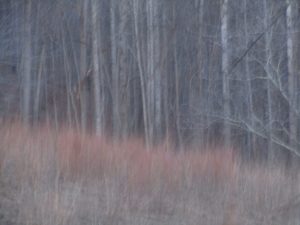A good month away from the equinox and vibrant color wakes up the winter doldrums. Brand new ribbons of witchhazel contrast with wrinkled amethyst berries of Callicarpa dichotoma, Japanese beautyberry. Beautyberries, like viburnums, are one of the last berries to be eaten by the birds, seeing them through the hungry days of late winter.
Spied the first robins, poking for worms below the pines on the walk past the potting shed the other day. Smelled a poor dead skunk on the road. Sure signs of spring. The forysythia, spicebush, and lonicera buds are swelling, Hellebores beginning to bloom. There will be a cold snap, which will distress the fruit growers, but spring is swelling up now.
Ruby red ‘Diane’ (Hamamelis x intermedia, a cross between Japanese and Chinese varieties) has heralded spring in the hollow for many years. So glad we did not cut it to the ground after extensive storm damage a few years ago, and left a solid structure of old branches instead. Nursing along and thinning the new growth on this treasured specimen is a pleasant pruning challenge.
The rusty red of the broom-sedge in the east meadow echoes the old season with the copper color of winter-overed beech leaves. We plan to bushhog it at the end of the month, before deer or other animals start nesting for the spring. It’s always good to walk a field like this before mowing, not only to look for nestlings, but to spot rocks and other impediments.
Rainfall is up over the last weeks, though we’re still recovering from a deficit of 11″ last fall. It’s good to hear the creek running and sop around in my boots. Mud season is welcome. We’ve been blessed with little snow or ice.
Out with the old, in with the new.



